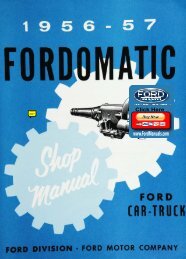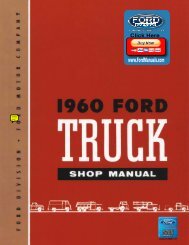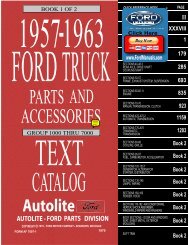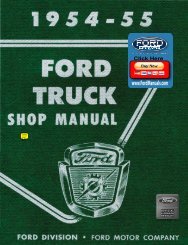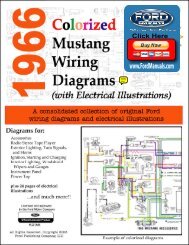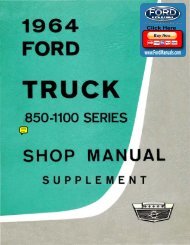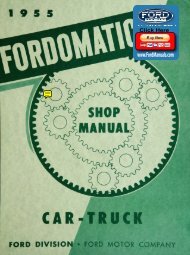DEMO - 1956 Ford Car Shop Manual - FordManuals.com
DEMO - 1956 Ford Car Shop Manual - FordManuals.com
DEMO - 1956 Ford Car Shop Manual - FordManuals.com
- No tags were found...
You also want an ePaper? Increase the reach of your titles
YUMPU automatically turns print PDFs into web optimized ePapers that Google loves.
28 Chapter 1 General Engine Overhaul, Inspection, and Repairaccording to the instructions on the piston ring package,check the ring side clearance with a feeler gauge. Thegauge should slide freely around the entire piston ringcircumference without binding.If the rings are to be installed in a used cylinder, remove the "glaze" on the bore as previously explained.(5) FITTING PISTON PIN. The piston pin fitshould be a light thumb press fit at normal temperature(70F). Standard piston pins are color coded green. Pinsof 0.001 inch oversize (color coded blue)and 0.002 inchoversize (color coded yellow)are available.If the piston pin hole must be reamed, use an expansion-type, piloted reamer. Place the reamer in a viseand revolve the piston around the reamer. Set the reamer to the size of the pin bore, then expand the reamerslightly and trial ream the pin bore. Take a light cut.Use a pilot sleeve of the nearest size to maintain alignment of the bores.Check the reamed hole size, using the new piston pin.ft W 6485Fig. 41 Measuring Piston Ring Gap Typicalgoing to be used. Push the ring down into the bore areawhere normal ringwear is not encountered. Use the headof a piston to position the ring in the bore so the ringis square with the cylinder wall. Use caution during thisoperation to avoid damage to the ring or cylinder bore.Measure the gap between the ends of the ring with afeeler gauge (fig. 41). The gap should be from 0.010-0.027 inch. If the gap is less than the lower limit, tryanother ringset. After the rings have been fitted in thecylinder bore, immediately install them on the piston,or identify them with the piston and cylinder in whichthey are to be installed.After the rings have been installed in the ring groovesIf the bore is small, expand the reamer slightly and makeanother cut. Repeat the procedure until the proper fitis obtained. Check the fitted piston pin for fit in therespective rod bushing. Ream the bushing if necessaryto fit the pin.Install the piston pin in the piston and rod. Install aretainer at each end of the pin to hold it in place. Whenthe retainers are installed, make sure they are properlyseated in the grooves provided in the piston pin bore.Always use new retainers.c.Connecting Rod.The connecting rods and related parts should be carefully inspected and checked for conformance to specifications. Various forms of engine wear which are causedby these parts can be readily identified as follows:A shiny surface on the pin boss side of the pistonusually indicates that a connecting rod is bent or thepiston pin hole is not in proper relation to the pistonskirt and ringgrooves (fig. 42).Abnormal connecting rod bearing wear can be causedby either a bent connecting rod, a crankshaft journalimproperly machined, or a tapered connecting rod bore(fig. 43).Twisted connecting rods will not create an easilyidentifiable wear pattern, but badly twisted rods willdisturb the action of the entire piston, rings, and rodassembly that mayresult in excessive oil consumption.(1) CLEANING AND INSPECTION. Clean all partsand passages in solvent. Never use a caustic cleaningPISTON WEAR CAUSED BY BENT RODOR MISALIGNED PISTON PIN HOLE 6371Fig. 42 Wear Pattern on Piston Piston Pin Boss Surfacesolution. Remove the bearings (identify them if they areto be used again), then thoroughlyclean the rod boreand the back of the bearings. For the different types ofbearing failures and their causes, refer to Section 7.Make sure the oil squirt holes are open.



